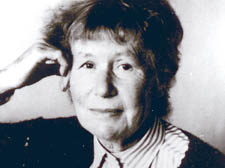|
|
 |
| |

Penelope Fitzgerald: her true self only revealed in her novels |
The chaotic grandma whose genius won literary acclaim
Penelope Fitzgerald’s eccentricity masked a fierce intellect which only came into its own in her later years, writes Gerald Isaaman
So I Have Thought of You: The Letters of Penelope Fitzgerald.
Edited by Terence Dooley. order this book
Fourth Estate £25
IF the novelist Penelope Fitzgerald had been a willing victim of today’s indulgent TV series Who Do You Think You Are?, you would be in for an enthralling story of an extraordinary, ordinary person. She was indeed a contradiction, someone whose life personified perfection and imperfection in dual doses.
She had the perfect start, born in Hampstead in 1917, the daughter of Punch editor Edmund “Evoe” Knox, with a bishop as her great-grandfather, a missionary in Afghanistan as her grandfather and three eccentric Knox uncles of considerable amusing talent.
But that bedrock shattered after her husband Desmond returned a hero from the Second World War, nightmares of his experience turning him into an alcoholic, forever funny but helpless.
And long before he died in 1976 she became responsible for bringing up their three children – working in a bookshop in Suffolk, as a tutor of students wanting to get into Oxford – anything to make life tolerable for them. Too often she was penniless and reduced to cooking them just a dish of potatoes.
They lived chaotically – on a houseboat on the Thames at Battersea that sank twice, in a disused factory in Hackney given over to the homeless, on a squalid housing estate in south London – before something from her perfect past returned with a far more elegant home in Bishops Road, Highgate.
In the midst of all that disorder, Penelope became a writer, scribbling on backs of envelopes and in old exercise books. The subject of her first foray into biography was the Pre-Raphaelite painter Edward Burne-Jones, followed by a terrific biography of the Knox Brothers.
Then she turned to novels with the help of Primrose Hill publisher Colin Haycraft, who stupidly disowned her before she took the prestigious Booker Prize for Fiction in 1997 for Offshore, a slender tale of her sinking houseboat days. Yet that triumphant night she sat dazed at her table with hardly a word to say when I went to congratulate her.
Perhaps it was because she knew her victory was a compromise, the judges unable to agree which of the two front-runners should take the crown; maybe she had, at last, amazed herself.
She had been short-listed for the Booker before and would be once again, in between taking other literary praise and prizes for novels that searched the human heart with clarity and love as she turned tiny details and incidents, mainly from her own life, into explosive drama.
Then came the transformation, the huge intellectual leap to write compelling novels set in other countries and other times. It was a literary liberation from the age of 68 that produced, in particular, The Blue Flower to universal acclaim, a novel that marks her greatness.
Not bad for a grey-haired grandma who worried about finding speakers to perform at the Highgate Literary and Scientific Society, a dithering old woman who carried her life in her shopping bag, who rarely had anything to say to distraught journalists, though she was always kind to me.
Now we have a collection of her letters, lovingly put together by her family and edited by her son-in-law, Terence Dooley, which reinforce the picture of a remarkable woman who only revealed her true self in her novels.
They are by no means great letters and are put together in an incoherent way that makes them difficult to follow – true to Penelope’s domestic life? – and add only a little to our understanding of what exactly inspired her determination to rise to the heights.
Thankfully, they act as a wonderful reminder of her true talent.
And no doubt Penelope, who died in 2000 and lies buried high on Hampstead’s hill at St Mary’s, would have been pleased to be remembered in this way.
As Terence Dooley says in his introduction: “It occurred to me, during my researches for this book, to wonder where she worshipped when, at her lowest point she lived offshore on Grace. Her boat is described in this book as being moored on Battersea Reach; in reality it had been moored at Dakin’s yard, World’s End, but directly opposite St Mary’s Battersea.
“Inside that lovely 18th-century church, the first thing that one sees, among a wonderful collection of modern stained-glass windows, Blake and the grain of sand, Turner, Franklin and the promise of happiness, on the left side of the door is a large and beautiful blue flower.”
AS Byatt, with whom she worked as a tutor in her hard-up days, writes too: “Penelope was contradictory. She could appear vague and self-effacing and was. She could also say formidably knowledgeable and percipient things about literature. She was generous and exacting. She once rebuked me for not understanding that one of her pupils had a touch of genius.”
It was dear Penelope in fact who not only recognised genius but had more than a perfect touch of it herself.
|
 |
|
 |
 |
|
 |
|



